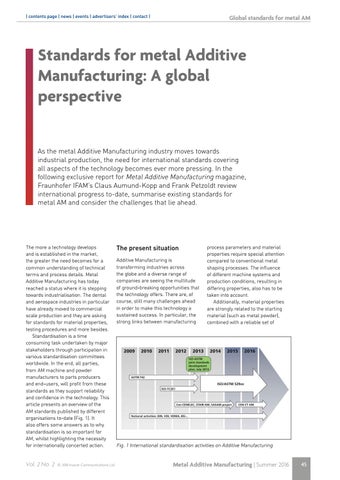| contents page | news | events | advertisers’ index | contact |
Global standards for metal AM
Standards for metal Additive Manufacturing: A global perspective As the metal Additive Manufacturing industry moves towards industrial production, the need for international standards covering all aspects of the technology becomes ever more pressing. In the following exclusive report for Metal Additive Manufacturing magazine, Fraunhofer IFAM’s Claus Aumund-Kopp and Frank Petzoldt review international progress to-date, summarise existing standards for metal AM and consider the challenges that lie ahead.
The more a technology develops and is established in the market, the greater the need becomes for a common understanding of technical terms and process details. Metal Additive Manufacturing has today reached a status where it is stepping towards industrialisation. The dental and aerospace industries in particular have already moved to commercial scale production and they are asking for standards for material properties, testing procedures and more besides. Standardisation is a time consuming task undertaken by major stakeholders through participation in various standardisation committees worldwide. In the end, all parties, from AM machine and powder manufacturers to parts producers and end-users, will profit from these standards as they support reliability and confidence in the technology. This article presents an overview of the AM standards published by different organisations to-date (Fig. 1). It also offers some answers as to why standardisation is so important for AM, whilst highlighting the necessity for internationally concerted action.
Vol. 2 No. 2 Š 2016 Inovar Communications Ltd
The present situation Additive Manufacturing is transforming industries across the globe and a diverse range of companies are seeing the multitude of ground-breaking opportunities that the technology offers. There are, of course, still many challenges ahead in order to make this technology a sustained success. In particular, the strong links between manufacturing
process parameters and material properties require special attention compared to conventional metal shaping processes. The influence of different machine systems and production conditions, resulting in differing properties, also has to be taken into account. Additionally, material properties are strongly related to the starting material (such as metal powder), combined with a reliable set of
Fig. 1 International standardisation activities on Additive Manufacturing
Metal Additive Manufacturing | Summer 2016
45
